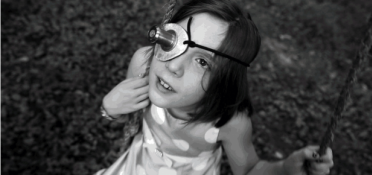CONTRIBUTOR’S NOTE
My coproducer for the project, Nicki Newburger, went out to find interesting people that we might make a short film about in South Memphis. I wanted to work in the area near the Stax Music Academy in hopes that we could involve its students musically with the production. Initially there was a theme we were working with, because the Crosstown Arts organization in Memphis put out a call to filmmakers to make a short film about the concept of “neighborhood” for an event they have called MemFEAST.
Nicki came back and rattled off a list of four or five folks who caught her eye. She said she found some twins, a guy in a wheelchair who drove an amazing tricked-out car, a girl who had a special tree, and a boy in love with the game of basketball. The girl with the tree jumped out at me, and I asked her to get more information.
She engaged in a series of brief preinterviews, and the information and photos she brought back got me more interested. We learned that the girl’s name was Faith and that she named her tree April. I saw that she could go inside her tree as a place of refuge and had a wonderful imagination. Then Nicki told me that just a few blocks away there was a woman named Hattie Mae who nailed hand-painted signs to a tree in her yard—an enormous battered stump on which she placed messages of positivity and observations of life.
To me, it was amazing that only several blocks apart were two residents of this neighborhood who had deep connections to two very specific trees; this was perfect for the neighborhood theme that the Crosstown Arts group had requested. I became immediately interested in linking Faith and Hattie Mae, somehow, through this connection they shared with their trees in the neighborhood affectionately called Soulsville.
I scheduled interviews with Hattie Mae and Faith. To create a sense of urgency, I capped the interviews at thirty minutes. My goal was to capture the moment, flow, and ideas that formed between the two of us in that space in time. I paid careful attention to the mood and atmosphere of the spaces we used for recording. I recorded Faith in a church sanctuary that felt very safe; we sat on the carpeted floor to be close to the earth. I recorded Hattie Mae in her cozy living room, where she was surrounded by images of the past, literally dozens of framed images of her family and occasions that marked special times for her.
I recorded Faith first, then invited Hattie Mae to echo some of the points that came up in Faith’s interview. Throughout I respected their silences and meanderings, then transcribed the two interviews.
These recordings were the basis for the film’s audio track. The actual words of the script were a combination of answers Faith and Hattie Mae gave to my questions, my own ideas that I asked them to say, or to interpret through their own experiences and feelings.
FAITH: Can I tell you a secret? I got a magical tree.
Faith’s opening line, for example, was the result of a specific prompt. I wanted her to use the words secret and magic to create a sense of wonder, to make the audience lean in. I asked Faith to call her tree magic to set up the concept of animistic thinking that I also encouraged Hattie Mae to continue in order to link the two spirits as one in childhood.
HATTIE MAE: Oh, if you could just see . . . if you knew!
I asked Hattie Mae to say this line in order to establish her as the voice of experience in this film. The imagery of seeing comes up a lot in “April.” Later when directing Faith, I asked her to pretend she had an eyeball on the end of each finger as she pokes her hand outside the tree to see the wind and to see if it is safe outside of April.
FAITH: When I’m inside my tree, I can hear the wind.
Faith said this when I asked what she hears when she’s inside her tree.
HATTIE MAE: If I was the wind . . . oooh weee! . . . the sound that I would make, if I was a bird.
Knowing that Hattie Mae has difficulty with mobility, I had asked her what it would be like if she was the wind (pushing off what Faith had said earlier about hearing the wind) or a bird. I thought this imagery was a good way to explore the animistic thinking of a child. And I wanted to reconcile that view with an older adult’s sense of life as fleeting, as ephemeral.
FAITH: I bring water to my tree . . . so she can grow. My tree watches me grow.
HATTIE MAE: My tree . . .
HATTIE MAE: But you think you gonna be young forever.
HATTIE MAE: That is all life is to us now. A moment. It is like a vapor.
Hattie Mae’s voice layered over the shots of children running, flying over trees and over childhood, further establishes her as a kind of swirling, mystical force. When she says that we have to keep the faith when we experience loss or hurt, I believe her.
When I asked Faith the question “What makes you scared?” she said that people shooting guns around her made her scared. So I asked her to mimic that sound:
FAITH: Sometimes, people shoot guns in my neighborhood. It makes me scared. They make pow pow pow pow sounds.
I consider “April” to be a blend of fiction and nonfiction. I was experimenting with a concept Werner Herzog taught me: that invention, as opposed to just recording the facts like an accountant, can lead to deeper, universal, and ecstatic truth. Since I come from a journalism background, this made me curious. With “April” I wanted to explore this space a little further.
Faith and her tree are real. Hattie Mae and her tree are real. In reality they did not know of each other’s existence. Nor would they have arrived at the words or concepts in the film on their own without my focusing their attention on a certain space and tone.
But the experiences they shared are all real. Gunshots do ring out at Faith’s apartment. You can see bullet holes in the walls. She really does water her tree to help it grow. She does hide in the tree sometimes when she’s scared. Same with Hattie Mae’s experiences and what she talks about. By linking the two, I tried to create a strong theme that an audience could connect to emotionally.



